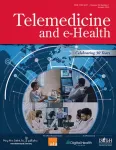(Press-News.org) It has long been known that agricultural pesticides are one of the greatest threats to bees and other essential pollinators. What farmers have lacked is an understanding of how different pesticides, applied at various times on a variety of crops, affect the risk of exposure to bees living near the fields.
Researchers have drawn from real-world data to try to address this gap, developing and testing a spatial model for predicting pesticide exposure in bumblebees. The journal Science of the Total Environment published the work, based on the interactions of the yellow-faced bumblebee (Bombus vosnesenskii) with crops in California.
“We were able to explain nearly 75% of the spatial variation in pesticide exposure among the bumblebee hives using our model,” says Eric Lonsdorf, first author of the study and assistant professor in Emory’s Department of Environmental Sciences.
Relatively simple models were more effective at preventing exposures than the researchers expected.
“Our results suggest that simply data on where and when a pesticide was sprayed is all that you need to make a good prediction for the threat to nearby hives,” Lonsdorf says.
Including data on how long a particular chemical lingers in the landscape or how attractive the flowers in a particular crop are to the bees did not make a significant difference in the model’s predictive power.
“We found that even if a crop is not that attractive to the bees, the chemicals from that crop are still going to be found in their pollen,” Lonsdorf says. “The bees may be picking up the chemical due to drift of the pesticide onto nearby weeds where they are foraging.”
Providing tools for conservation
Lonsdorf studies natural capital, or nature’s contributions to humans. He translates ecological principles and knowledge into predictive models that enable industry leaders and policymakers to better manage natural resources.
He’s currently using models he developed to help the U.S. Fish and Wildlife Service identify bee conservation priority areas in the United States.
More research is needed, Lonsdorf says, to determine whether the bumblebee risk-prediction model will scale up across different landscapes and for different species of bees. The current study also did not delve into how the amount of a particular pesticide found in the pollen translated into toxicity for the bees.
Co-authors of the paper include Neal Williams from the University of California, Davis, and Maj Rundlöf and Charlie Nicholson, who are affiliated with the University of California, Davis, and Lund University in Sweden.
Drawing from fine-scaled data
The researchers began with experiments set amid a variety of crops in northern California’s Yolo County. Fourteen pairs of yellow-faced bumblebee colonies were placed around the agricultural landscape. This species of bumblebee is native to the West Coast and the most abundant wild species of bee in this range, found in both urban and agricultural areas.
Pollen that bees in each hive collected were sampled at six different times during the growing season. The pollen samples were then assessed for exposure to 52 different active ingredients encompassing a range of pesticides.
Data from these experiments were combined with field-level data from the California Department of Pesticide Regulation on what pesticides were sprayed and what days they were sprayed.
“California is unique in providing such fine-scaled, public data,” Lonsdorf says. “In most places in the United States, information on what pesticides are being sprayed is only collected at the county level and summarized on an annual basis.”
The detailed data allowed the researchers to consider a range of factors in their predictive model to identify those factors with the most predictive power.
“Our risk-prediction model marks another step toward evaluating pollinator-conservation issues to help guide policies for pollinator landscapes,” Lonsdorf says. “The next step is to do a field-toxicity assessment to get a better understanding of how pesticides are affecting bee health.”
He and colleagues are now conducting such a study with honeybees, he adds.
The current paper was supported by the National Science Foundation, California Department of Food and Agriculture, Almond Board of California, KIND Foundation Fund for Pollinator Health and the Swedish Research Council.
END
Spatial model predicts bumblebee exposure to pesticide use
A simple model to help conserve an important pollinator
2024-01-29
ELSE PRESS RELEASES FROM THIS DATE:
A firm eye on the proboscis
2024-01-29
EMBARGOED UNTIL MONDAY, 29 JANUARY 2024, 21:00 CET (20:00 LONDON TIME, 15:00 U.S. EASTERN TIME)
Have you ever seen a hummingbird hawk moth? When people encounter this moth for the first time, they are usually intrigued: Looking like a cross between a butterfly and a bird – hence the name – this animal has the amazing ability to hover like a helicopter for long periods. On closer inspection, another feature of the hummingbird hawk moth quickly catches the eye: the spiralling curled proboscis, which is as long as the entire animal.
The moth uses its proboscis ...
Viral protein fragments may unlock mystery behind serious COVID-19 outcomes
2024-01-29
There are many lingering mysteries from the COVID-19 pandemic. For instance, why does SARS-CoV-2, the virus behind the disease, cause severe symptoms in some patients, while many other coronaviruses don’t? And what causes strange symptoms to persist even after the infection has been cleared from a person’s system?
The world may now have the beginning of answers. In a study published today in the journal Proceedings of the National Academy of Sciences, a UCLA-led multidisciplinary research team explores one way that COVID-19 turns the ...
Endangered seabird shows surprising individual flexibility to adapt to climate change
2024-01-29
New research finds that individual behavioural flexibility and not evolutionary selection is driving the northward shift of Balearic shearwaters.
The findings were revealed through a decade-long study which tagged individual birds.
The results indicate that individual animals may have greater behavioural flexibility to respond to climate change impacts than previously thought.
How individual animals respond to climate change is key to whether populations will persist or go extinct. Many species are shifting their ranges as the environment warms, but up to now the mechanisms underlying ...
Spacing characteristics between vegetation could be a warning sign of degrading dryland ecosystems - study
2024-01-29
Scientists have found that the spatial arrangement of plants in drylands can be a sign of the environment degrading, according to a new study.
One of the iconic features of drylands is the striking appearance of islands of plants surrounded by bare soil. This spatial structure of arid vegetation has long fascinated scientists, but now a new study published in Proceedings of the National Academy of Sciences, has shed new light on why these plants group in this way.
An international team of scientists, including from the University of Birmingham, combined field data from 115 sites around the world, and used mathematical models and remote sensing to build a picture of how the ...
Researchers spying for signs of life among exoplanet atmospheres
2024-01-29
COLUMBUS, Ohio – The next generation of advanced telescopes could sharpen the hunt for potential extraterrestrial life by closely scrutinizing the atmospheres of nearby exoplanets, new research suggests.
The next generation of advanced telescopes could sharpen the hunt for potential extraterrestrial life by closely scrutinizing the atmospheres of nearby exoplanets, new research suggests.
Published recently in The Astronomical Journal, a new paper details how a team of astronomers from The Ohio State University examined upcoming telescopes’ ability to detect chemical ...
People are inclined to hide a contagious illness while around others, research shows
2024-01-29
A startling number of people conceal an infectious illness to avoid missing work, travel, or social events, new research at the University of Michigan suggests.
The findings are reported in Psychological Science, a journal of the Association for Psychological Science. Across a series of studies involving healthy and sick adults, 75% of the 4,110 participants said they had either hidden an infectious illness from others at least once or might do so in the future. Many participants reported boarding planes, going on dates, and engaging in other social interactions while secretly sick. More than 61% of healthcare workers participating in the study also ...
Racial and ethnic differences in hypertension-related telehealth
2024-01-29
A new study in the peer-reviewed journal Telemedicine and e-Health found that hypertension management via telehealth increased among Medicaid recipients regardless of race and ethnicity during the COVID-19 pandemic. Click here to read the article now.
Jun Soo Lee, PhD, from the Centers for Disease Control and Prevention (CDC), and coauthors, reported that from February-April 2023, the number of hypertension-related telehealth outpatient visits per 100 persons increased from 0.01 to 6.13, and the number of hypertension-related in-person visits decreased from 61.88 to 52.63.
The investigators ...
Henry Ford Health helps advance precision medicine research in Michigan
2024-01-29
Michiganders will continue to have the opportunity to advance medical research aimed at advancing individualized health care through a renewed award to Henry Ford Health + Michigan State University Health Sciences from the National Institutes of Health’s (NIH) All of Us Research Program. The award includes $18.3 million in initial funding to support a consortium of 8 health care provider organizations with a presence in 16 states.
Henry Ford has led the consortium since 2017. The renewed award allows participation to continue until at least 2028. The multimillion-dollar multi-year award represents the largest NIH research grant in Henry Ford’s 108-year history.
All ...
Jobs and geography may affect hearing: New study maps hearing loss by state and county across the US
2024-01-29
Chicago, IL – January 24, 2024 – The first study to map the prevalence of bilateral hearing loss in the United States by state and county finds that rates of hearing loss are higher among men, non-Hispanic Whites, and residents of rural areas. Bilateral hearing loss is hearing loss in both ears.
West Virginia, Alaska, Wyoming, Oklahoma, and Arizona had the highest rates of hearing loss, while the District of Columbia, New Jersey, New York, Maryland, and Connecticut had the lowest (see top ten highest and ...
UChicago engineer driving key role in Great Lakes water transformation
2024-01-29
The Chicago-based Great Lakes ReNEW coalition has been awarded one of the largest, if not the largest, climate awards in the city’s history – up to $160 million over 10 years as one of the inaugural U.S. National Science Foundation’s Regional Innovation Engines.
Authorized in the “CHIPS and Science Act of 2022,” the NSF Engines program is designed to support the development of diverse regional coalitions of universities, local governments, the private sector and nonprofits to create solutions to today’s pressing issues.
Selected from an initial pool of more ...
LAST 30 PRESS RELEASES:
Study: Teens use cellphones for an hour a day at school
After more than two years of war, Palestinian children are hungry, denied education and “like the living dead”
The untold story of life with Prader-Willi syndrome - according to the siblings who live it
How the parasite that ‘gave up sex’ found more hosts – and why its victory won’t last
When is it time to jump? The boiling frog problem of AI use in physics education
Twitter data reveals partisan divide in understanding why pollen season's getting worse
AI is quick but risky for updating old software
Revolutionizing biosecurity: new multi-omics framework to transform invasive species management
From ancient herb to modern medicine: new review unveils the multi-targeted healing potential of Borago officinalis
Building a global scientific community: Biological Diversity Journal announces dual recruitment of Editorial Board and Youth Editorial Board members
Microbes that break down antibiotics help protect ecosystems under drug pollution
Smart biochar that remembers pollutants offers a new way to clean water and recycle biomass
Rice genes matter more than domestication in shaping plant microbiomes
Ticking time bomb: Some farmers report as many as 70 tick encounters over a 6-month period
Turning garden and crop waste into plastics
Scientists discover ‘platypus galaxies’ in the early universe
Seeing thyroid cancer in a new light: when AI meets label-free imaging in the operating room
Neutrophil-to-lymphocyte ratio may aid risk stratification in depressive disorder
2026 Seismological Society of America Annual Meeting
AI-powered ECG analysis offers promising path for early detection of chronic obstructive pulmonary disease, says Mount Sinai researchers
GIMM uncovers flaws in lab-grown heart cells and paves the way for improved treatments
Cracking the evolutionary code of sleep
Medications could help the aging brain cope with surgery, memory impairment
Back pain linked to worse sleep years later in men over 65, according to study
CDC urges ‘shared decision-making’ on some childhood vaccines; many unclear about what that means
New research finds that an ‘equal treatment’ approach to economic opportunity advertising can backfire
Researchers create shape-shifting, self-navigating microparticles
Science army mobilizes to map US soil microbiome
Researchers develop new tools to turn grain crops into biosensors
Do supervised consumption sites bring increased crime? Study suggests that’s a myth
[Press-News.org] Spatial model predicts bumblebee exposure to pesticide useA simple model to help conserve an important pollinator




